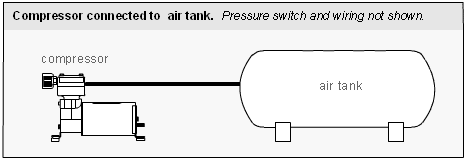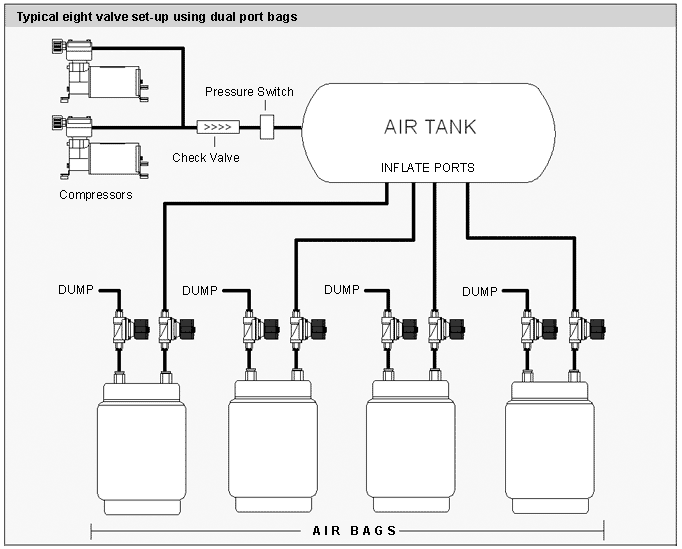The term fast bag
refers to an air suspension systsem that operates fast, ie - it airs up and down
quickly. To do this, the vehicle must have some type of on board air compressor
and reserve tank. Typical aftermarket air suspension systems use 150psi and come
with a small tank, usually between 3-6 gallons. Solenoid operated valves are typically
used to inflate and deflate the bags. Solenoid valves are great because they ease
the plumbing of the system and allow the system to be controlled electronically.
So now that you have
your air tank, 12V compressor and solenoid valves, how does everything work? The
way it works is simple. The compressor has only one responsibility: keep the tank
full. The valves allow air into and out of the bags by opening and closing the
connection between the air tank and the air bags.

That's the grunt of the process, but there's really a lot more involved than that,
here's a more detailed description of the parts and how they actually work:

Click
parts to view detailed description.
ABOVE:
This is what a
typical 8 valve set-up using dual ports bags looks like. Each bag has two valves,
one for inflate and one for deflate. The tank has four separate ports that supply
each bag. The pressure switch tells the compressors when to run and when to shut
down. The check valve allows air to flow in only one direction and is cheap insurance
against leaks at the compressors. Essentially, the pressure switch is isolated
from the compressors by the check valve. Flow rate on the compressor side of the
check valve is not important since the compressors can only put out a small amount
of air per minute. On the other side of the check valve, everything needs to be
maximized for high flow capability. That means lines, fittings, tank ports and
bag ports must all be considered. I use an air dryer and a water separator in
my system for additional insurance against water and particle build up.
THE COMPRESSOR
AND THE PRESSURE SWITCH:
As I said earlier, the compressor's sole purpose in life is to keep the tank full. It does this via a pressure switch. The switch is mounted between the compressor and the tank. It has a pressure 'window' that opens or closes the contacts of the switch. I use a 110-145psi switch. That means when pressure is below 145psi, the switch is closed, causing the compressor to run. When pressure reaches 145psi, it opens and turns off the compressor. The 110psi is the lower limit where the switch will close again and activate the compressor. For example, you wouldn't want the pump(s) to come on every time the pressure dropped to 139psi. The 110 limit is there to make it practical.
Create an index page for the various valve arrangements.
Clickable picture that explains the different components, or a FLash Movie.
Inherent problems: LOSS OF PRESSURE, RECYCLING AIR, COMPARE TO HYDROS
Use schematics with each description, some people are more visual learners.